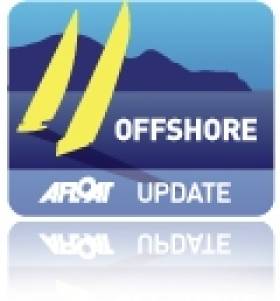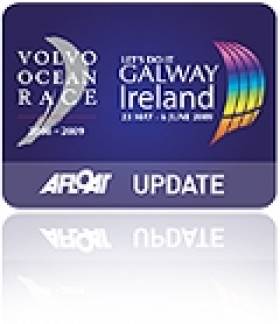Displaying items by tag: Discover Ireland
The Discover Ireland sailing team that featured in WM Nixon's Saturday Sailing blog debuted on Galway bay in the Clarenbridge trophy offshore race yesterday.
The race is sailed over a course from the GBSC start line at Renville to Finis Rock off Inis Oir then onto Canon Rock in the entrance to Rossaveal Harbour before a finish in Renville total distance approx 60 miles.
Yesterday's race saw winds between 25-40 knots which made for a tough beat all the way to Inis oir, but Discover Ireland stretched its lead all the way out of the bay on its nearest competitor "Ibaraki".
Drivers Ben Scallan and Neil Spain made light work of the beat with a full main and a no 4 jib, things eased a little for the fetch up to Rosaveal, but the team still managed to break a kicker and lost instruments temporarily in the lumpy seas encountered.
Then it was kite up in winds which were now sitting between 30-35 knots for a fantastic reach/run home to renville.
Boat speed was sitting above 12 knots the entire time with speeds of up to 18 knots in the heavier gusts.
The boat loved the conditions which is a great reflection on this 15–year–old Stimpson design.
They completed the course in 7 hours 7 minutes in first place and with line honours and the race was an excellent shakedown for a busy season ahead.
The boat's next trip is the delivery to the Scottish series leaving Galway this Friday so skipper Aodhan Fitzgerald is hoping that the present strong westerly flow will abate.
Surfing in Ireland For Experts and Learners Alike
#SURFING - Discover Ireland guest blogger Mark Folens jumps right into the deep end as he explores one of the many options for those learning to surf in Ireland.
Despite describing himself as "not really the beaches type", Folens braved the beaches of Bundoran at dawn with a group of fellow novices for his first lesson.
"To stand on a surfboard you must lie on your chest and push yourself up with your arms while tucking your legs in beneath you," he writes.
"This might sound easy but if you have the arms of a Tyrannosaurus Rex and upper-body strength of an eight-year-old girl like me, it’s a bit of a challenge."
And that was on the relative ease of dry land - it would be a different story once Folens took to the water!
The Discover Ireland blog has more on the story HERE.
Irish Sailors Get Ready for First VOR In-Port Races
The first of the in-port races ahead of the Volvo Ocean Race start tomorrow in Alicante – and top Irish sailors are among the six teams competing.
Wexford’s Justin Slattery is on Abu Dhabi Ocean Racing, which is competing in the race for the first time.
Skipper Ian Walker told Sail World: "Everything is ready and we can’t wait to line up against the other teams... The forecast is for strong breeze on Saturday so there will be extra pressure on the crew to get it right."
The team has another Ireland connection in its commercial director David Hassett, a veteran of the Irish yachting scene and backer of Ireland's Green Dragon team in the 2009 race.
Elsewhere, Kerryman Damian Foxall is a watch leader on Groupama, captained by debuting VOR skipper Franck Cammas - who last month received one of France's most prestigious sporting honours.
Meanwhile, the Chinese entry Team Sanya, which is part sponsored by Discover Ireland, is hoping skipper Mike Sanderson - who took Telefónica Blue to the podium at every stage in the 2009-09 race - can repeat his past successes.
In-port races take place in all 10 host ports along the 39,000-nautical-mile route, and as they account for more than 20% of the points, no team will be taking them easy.
As previously reported on Afloat.ie, a delegation from Galway - hosts of the final stage of the race next summer - will be in Spain for a week of events beginning tomorrow ahead of the start of the race proper on 5 November.
Sail World has more on the story HERE.
































































